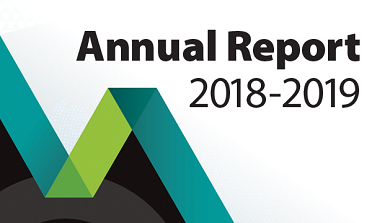Table of contents
- Veterans Ombudsman’s Message
- Deputy Veterans Ombudsman’s Message
- Our Work: Lives Helped
- Our Work: Receiving and Resolving Complaints
- Our Work: It’s About Fairness
- Our Work: Investigating Systemic Issues
- Our Work: Sharing, Listening, & Staying Connected
- Financial Statement
Veterans Ombudsman’s Message

I am pleased to share the 2018-2019 Office of the Veterans Ombudsman (OVO) Annual Report with you. Throughout the past year, the OVO continued its work to advance fairness for Veterans and their families with a particular focus on the issues of: wait times; financial security; and, transition. I would like to take this opportunity to acknowledge the work of my predecessor, Mr. Parent, and the entire OVO team, for all that they have accomplished on behalf of Veterans in these and other areas.
As indicated later in this report, wait times and the backlog associated with the adjudication of individual claims are the most frequent complaints that we continue to receive from Veterans. Quite simply, this needs to change. Veterans wait far too long for the financial compensation they are due and, perhaps most importantly, the medical treatment they require. I urge Government to take the necessary steps to address this significant and growing problem.
Having had the opportunity to engage with Veterans and Veterans groups, I have been struck by the significant degree of change that has occurred in the Veterans’ file over a very short period of time and the impact of that change. Since the introduction of the Veterans Well-being Act in 2006, there have been five major changes to Veterans’ legislation and 20 benefit programs introduced, modified and/or terminated. This has resulted in three distinct Veteran benefit regimes: the Pension Act; the Veterans Well-being Act; and most recently, Pension for Life.
These changes, which were accompanied by considerable government investment, have clearly helped some Veterans and their families. However, these changes have also resulted in further inequity and complexity for others. Inequity because Veterans with similar injuries are not always treated the same. Complexity because Veterans and their families must navigate a confusing web of legislation, programs and services.
What strikes me the most about the current situation is the fact that such significant change has occurred without meaningful consultation with Veterans and Canadians and with limited public debate on outcomes. Indeed, at present we have no clearly defined Veteran outcomes. As a result, it is difficult to determine whether or not current programs and services are meeting the needs of our Veterans.
As we head into 2019-2020, a year with a new government mandate, I urge Government to engage in meaningful consultation with Canadians in an effort to identify clear Veteran outcomes that over time could inform future changes to Veterans programming and enable the harmonization of the three existing benefit regimes. Doing so would enable us to address existing inequity and reduce complexity. Failing to do so will simply ensure enduring inequity and complexity and not surprisingly, frustration amongst some members of the Veterans' community.
In addition to responding to these and other issues raised by Veterans, our office looks forward to advancing in 2019-2020 our two main priorities which are Women Veterans and Supports for Families.
If you have thoughts or ideas on these, or any other Veterans issue, I encourage you to contact our office. We want and need to hear from you as we work to advance fairness for Veterans and their families.
Deputy Veterans Ombudsman’s Message
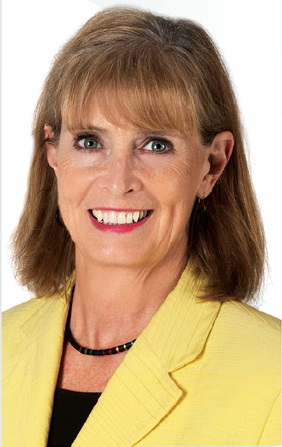
This Annual Report provides the opportunity to highlight the impact our office achieved during 2018-2019. I am proud of the Office of the Veterans Ombudsman (OVO) team’s continual dedication to achieving fairness for Veterans and their families.
Highlights
The impact of our work is illustrated in the stories featured in this report. Sometimes our work uncovers systemic unfairness, such as Veterans Affairs Canada’s (VAC) $165 million accounting error that short-changed 270,000 Veterans and survivors on the amount of disability pension paid out. In another instance, our complaint intervention ensured that a Veteran received the accessible shower needed to enhance their quality of life and remain at home. I invite you to read these stories to understand the different ways the OVO can help.
This year we received our largest number of complaints related to VAC’s lack of timely decision making. Our systemic investigation “Meeting Expectations: Timely and Transparent Decisions for Canada’s Ill and Injured Veterans” shone a light on several issues related to turnaround times, including delays for both Women and Francophone Veterans. It also cited seven recommendations for improvement. Our Annual Report Card detailed VAC’s progress in implementing our recommendations.
Year Ahead
In the coming year, a new structure will be implemented to expedite individual investigations and frontline staff will be added to our Ottawa location. This will expand the OVO’s hours of operation and capacity to respond to complaints. Going forward, we will continue to use the recommendations received from our client feedback survey to improve service delivery. As well, the Strategic Review and Analysis team will launch new micro investigations into systemic issues of unfairness that might not require the same deep dive as a full investigation. This will enable us to respond promptly to emerging issues.
Finally, we want to hear from Veterans and their families when they feel that they have not been treated fairly by VAC, were not given a fair opportunity to explain their case, or the decision made by VAC did not result in a fair outcome.
I invite you to stay connected with the OVO throughout the year via our social media channels and by visiting our Web site.
Our Work: Lives Helped
VAC Accounting Error Impacts Veterans

During the 2018-2019 year, the Office of the Veterans Ombudsman (OVO) saw Veterans Affairs Canada (VAC) take responsibility for a $165 million dollar accounting error that impacted more than 270,000 disabled Veterans and survivors across the country.
The miscalculation was uncovered during our analysis of VAC’s worksheets after the federal government announced changes to the Disability Award in 2016. By the OVO’s calculations, VAC had made a significant oversight over a number of years by not factoring the provincial basic tax credit into their calculation of provincial income tax.
When the office recalculated worksheets from 2006 to 2010 with the provincial basic tax credit included, it became clear that Veterans with Disability Pensions had been receiving lower payments. Further, the OVO determined VAC had detected and corrected the accounting error in 2011, but no effort was made to notify or reimburse those who were impacted in prior years.
We brought the error to VAC’s attention in June 2017 and followed up diligently for over a year, awaiting confirmation of the error and encouraging the department to bring a solution forward in a time-sensitive manner.
In November 2018, the OVO and VAC both went public about the accounting error, with VAC stating that it planned to issue corrective payments and acknowledging the OVO for bringing the mistake to light. Reported as a national news story, the error captured the attention of Veterans across the country.
Bridging the Gap for a WWII Veteran Needing Care Options

Navigating VAC programs and eligibility criteria can sometimes feel daunting for Veterans, particularly when time-sensitive issues are involved. In many situations, effective communication from VAC to its clients makes the difference between a Veteran getting the help they need or falling between the cracks. The latter was the case of a Second World War Veteran and his son who contacted the OVO.
The 98 year-old Veteran lived with his son, but was waiting for a placement in a community care facility. After calling VAC to discuss funding options, they were both left confused by the lack of support and information provided. Unsure if VAC had provided fair treatment, they turned to the OVO for assistance.
The OVO Intervention Officer (IO) assigned to the case quickly found several underlying issues. They noticed the Veteran’s conditions had not been reassessed in over a decade and there was no consent on file authorizing VAC to legally discuss the situation with his family.
The IO also saw that the Veteran had inquired several times about the Veterans Independence Program (VIP) benefits. VAC had sent the Veteran application forms for this benefit, but none were returned.
Although VAC did send the forms, no additional instruction or help was offered to this elderly Veteran. The IO recognized that it would have been reasonable for VAC to follow up on completion of the forms. The IO
The OVO remedied this by escalating the matter to a Veterans Service Team Manager at VAC who arranged for a staff member to connect with the Veteran and his family. VAC assigned a Veterans Service Agent to the case to help the Veteran receive the support needed to access the benefits that he was eligible for.
Sometimes our job is to reconnect broken links between Veterans and those who can help meet their needs. This story is just one example where the OVO facilitated that outcome.
Aging at Home: Helping a Veteran Secure Needed Renovations
A little home adaptation can go a long way, especially when it improves a senior citizen’s quality of life. For many, the ability to remain safe at home means everything to their independence.
A Korean War Veteran and his family were in the midst of adapting his home when they reached out to the OVO with concerns. The Veteran had applied to build a wheelchair accessible shower in his basement as a treatment benefit through the Program of Choice for special equipment (POC13). VAC denied the funding.
The Veteran, deemed frail but determined to stay at home, spent most of his days on the lower level where he felt most comfortable. Yet, VAC denied funding for the shower based on the fact that the Veteran had access to a bathtub on the main floor when using a stair lift. The family was also told that they did not have the necessary documentation for the department to consider approval.
Getting to the main floor bathtub presented serious risks to both the Veteran and his elderly wife. Bathing many times a day was a necessary task for the Veteran, who relied on his elderly wife to help him onto the stair lift. The frequency of this task increased the chance of falls. The Veteran’s family believed an accessible shower on the lower level would create a safer and healthier environment for all.
An OVO Intervention Officer (IO) objectively assessed the Veteran’s file and found that VAC had not gathered additional information needed, such as an Occupational Therapist’s assessment, to make a reasonable decision. The IO determined that the Veteran was treated unfairly.
In search of a fairer outcome, the OVO contacted a Veterans Service Team Manager on the Veteran’s behalf to present the facts. As a result, the renovations were approved. The VAC Area Office was then notified to move forward, and the construction of a wheelchair accessible shower began.
This is just one example where the OVO’s intervention helped advance fairness and improve daily life for a Veteran.
Our Work: Receiving and Resolving Complaints
The Intervention Unit is the Office of the Veterans Ombudsman’s (OVO) frontline team responsible for the intake, investigation, and resolution of individual complaints received from Veterans and their families. More than 2,000 new files were opened in 2018-2019 - the third highest number since the OVO’s inception10 years ago. The team addressed a total of 2,144 inquiries and complaints, including both new files and those carried over from the previous year.
In 2018-2019, several innovations were implemented to enhance the quality of service that the team provides. Veterans’ evaluation of service quality was expanded through a feedback questionnaire. The team received advanced communication skills training that was developed specifically to better meet the needs of clients with complex files.
With an eye towards the future, a comprehensive review of the Intervention Unit’s organizational structure was conducted. A new unit structure was then defined and will be ready to implement in 2019-2020. One major enhancement to follow is the creation of an independent intake function that will result in a specialized group of staff to working solely on the intake of complaints and the creation of files. This will help address some Veterans’ complaints more quickly, while prioritizing complex files for further investigation.
Intervention by the Numbers
In 2018-2019 the OVO received:
2,001 New Inquiries and Individual Complaints
- 1,681 Individual Complaints
- 320 Inquiries
Complaints by the Numbers
1,681 Complaints Received by OVO
- 121 Complaints Outside OVO Jurisdiction
- 407 Complaints Referred to VAC
1,153 Complaints Reviewed by OVO
- 628 Complainants Treated Unfairly
- 405 Complainants Treated Fairly
- 120 Complainant’s Files Under Investigation by OVO (ongoing)
Demographic Snapshot
By Issue Type

Alternative text
- Disability Benefits - 50%
- Financial Benefits - 9%
- Health Support - 20%
- Transition Support - 6%
- General Services - 10%
- VRAB - 4%
- OVO - 1%
By Client Group

Alternative text
- Former Regular Force Member - 64.13%
- Serving Regular Force Member - 13.25%
- Former Reserve Force Member - 8.82%
- Survivor/Family - 4.28%
- Former RCMP Member - 2.27%
- Traditional Veteran - 2.27%
- Serving Reserve Force Member - 1.51%
- Civilian - 1.26%
- Serving RCMP Member - 1.21%
- Allied Veteran - 0.50%
- Former RCMP Civilian Member - 0.20%
- Undefined/Not provided - 0.15%
- Serving RCMP Civilian Member - 0.05%
- Police- Peace keeping missions - 0.05%
- Merchant Marine - 0.05%
By Region

Alternative text
- West - 24.43%
- Atlantic - 20.20%
- ON - 29.47%
- QC - 22.92%
- Undefined/Not provided - 1.86%
- Foreign Countries - 1.11%
By Gender

Alternative text
- Male - 82.52%
- Female - 17.28%
- Undefined/Not provided - 0.10%
By Age
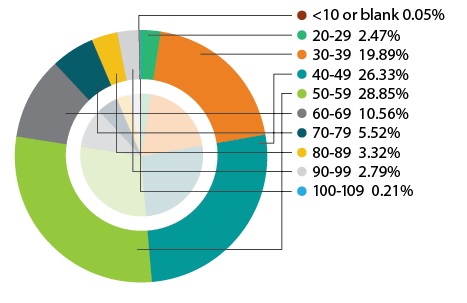
Alternative text
- <10 or (blank) - 0.05%
- 20-29 - 2.37%
- 30-39 - 19.89%
- 40-49 - 26.33%
- 50-59 - 28.85%
- 60-69 - 10.56%
- 70-79 - 5.52%
- 80-89 - 3.32%
- 90-99 - 2.79%
- 100-109 - 0.21%
Our Work: It’s About Fairness
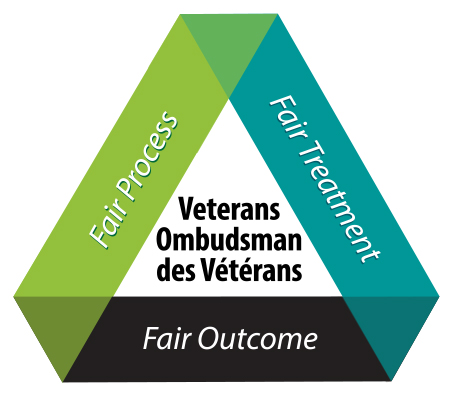
The Office of the Veterans Ombudsman (OVO) is an independent and impartial organization that fairly assesses complaints when individuals believe that they might have been unfairly treated.
At the OVO, we review all individual complaints and systemic issues through a fairness lens.
The OVO found that of the 1,153 complaints reviewed in 2018-2019, 628 complainants had been treated unfairly.
555 Related to Unfair Process
98% were associated with the time it takes to render a decision on the Veteran’s application for VAC benefits and services. Further, 498 were related to disability benefit applications and reassessments.
22 Related to Unfair Treatment
77% were related to either the lack of information or inaccurate information provided to Veterans regarding the programs and services potentially available to them.
51 Related to Unfair Outcome
65% were associated with an unfavourable decision for reimbursement of Veterans health care support claims with most being related to the Program of Choice (e.g. prescription drugs, physio/massage, special equipment, dental etc.)
How do we determine fairness?
Fair Process – How was it decided?
It includes an unbiased decision maker; notice of intent to make a decision; informing the Veteran of the decision-making criteria; an opportunity for the veteran to provide evidence; timely decisions; and meaningful reasons for the decision.
Fair Treatment – How was the Veteran or family member treated?
It includes being honest and forthright when communicating and providing clear, easy-to-understand information; respecting privacy rights; and treating Veterans with courtesy, dignity and respect.
Fair Outcome – What was decided?
The decision is based on relevant information; and made in accordance with applicable laws, regulations and rules that are fair. The decision should result in equitable outcomes and not be unduly oppressive. Similarly situated individuals should expect similar outcomes.
Our Work: Investigating Systemic Issues

The aim of the Office of the Veterans Ombudsman’s (OVO) investigation into systemic issues concerning Veterans Affairs Canada (VAC) programs and services is to improve the fair treatment of Veterans. Our Strategic Review and Analysis (SRA) team investigates systemic issues of unfairness, some of which are based on complaints and the feedback our office received during engagements with Veterans, their families, and Veterans’ organizations, among others.
From this work, the OVO makes recommendations to government and offers evidence-based advice to the Minister of Veterans Affairs to improve fairness of VAC’s various programs and services. Our findings and recommendations are available to the public via our Web site.
Snap Shot of 2018-2019 Publications
Veterans Ombudsman’s 2018 Report Card (July) detailed 10 years of OVO recommendations made, of which 46 had been acted upon in some form by Government.
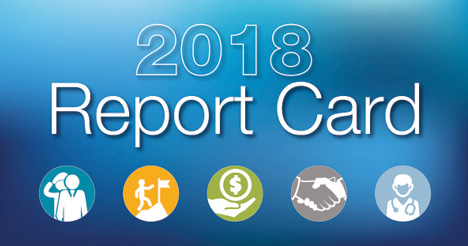
Meeting Expectations: Timely and Transparent Decisions for Canada’s Ill and Injured Veterans (September) put a spotlight on the lengthy and unreasonable delays that Veterans face while waiting for a disability benefit decision from VAC. The analyses, based on two random samples of completed disability benefit application files, revealed that not all groups of Veterans are treated equitably, and many applicants waited longer than the standard 16 weeks for a decision. For instance, women waited longer than men, and Francophone applicants waited longer than Anglophone applicants. Additionally Veterans with unmet healthcare needs could wait longer for a decision than others whose needs are already met due to discrepancies in the way the VAC Service Standard Start Date was established. Seven new recommendations were made, all aimed at securing equitable access to timely decisions for VAC clients, regardless of gender, language, or other factors. Four of these recommendations have either fully or partially been implemented by VAC.
Spouses Supporting Transition (October) detailed preliminary findings from a new qualitative study presented at the Canadian Institute for Military and Veteran Health Research forum.
Educational Infographic Series
Pension for Life: What’s Changing? clearly outlined changes that VAC’s Pension for Life plan brought about.
Meeting Expectations: Timely and Transparent Decisions for Canada’s Ill and Injured Veterans highlighted the findings and recommendations of the correlating report.
What to do if you disagree with VAC’s decision? outlined the options available to VAC clients if they find themselves disagreeing with a decision.
Pension for Life: What's changing?
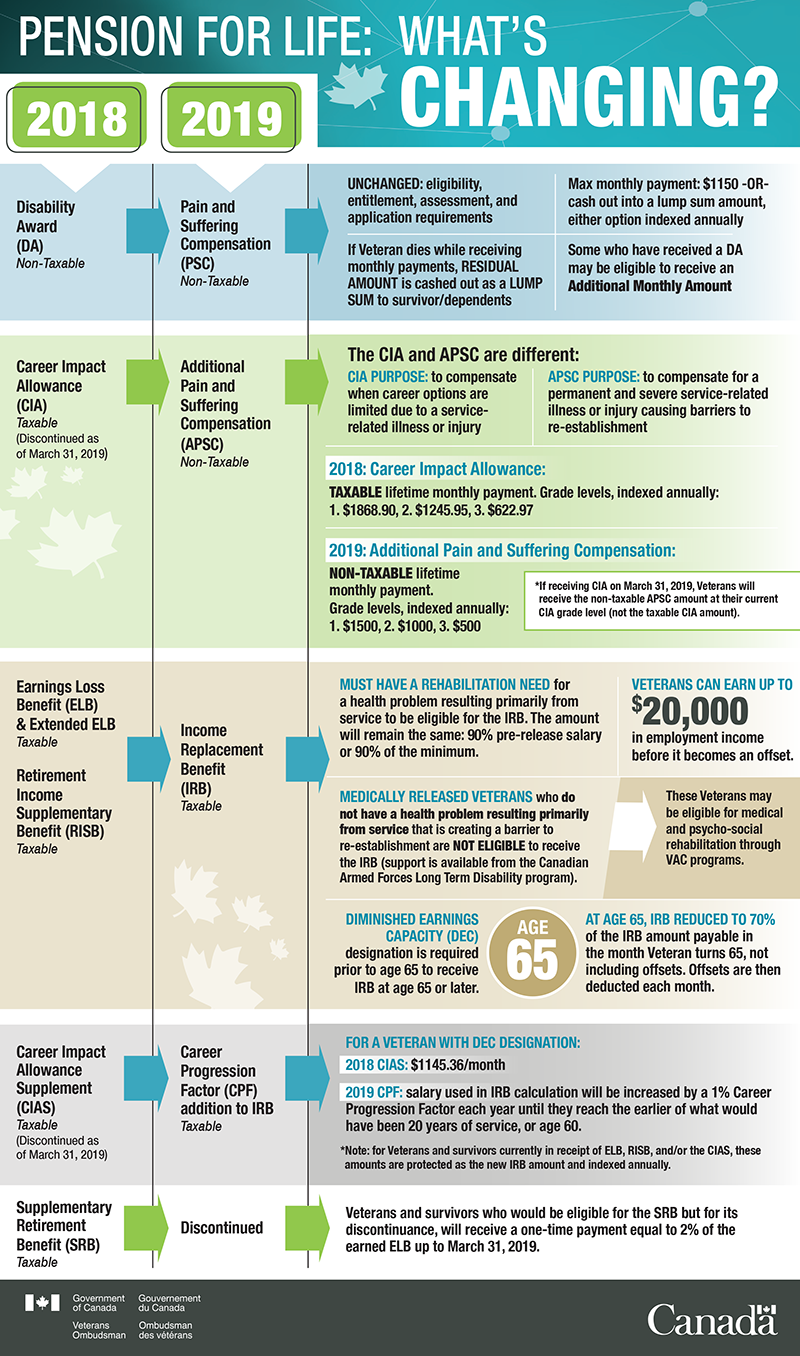
Alternative text
| 2018 | 2019 | ||
|---|---|---|---|
Disability Award(DA)Non-Taxable |
Pain and Suffering Compensation (PSC)Non-Taxable |
UNCHANGED: eligibility, entitlement, assessment, and application requirements | Max monthly payment: $1150 -OR- cash out into a lump sum amount, either option indexed annually |
| If Veteran dies while receiving monthly payments, RESIDUAL AMOUNT is cashed out as a LUMP SUM to survivor/dependents | Some who have received a DA may be eligible to receive an Additional Monthly Amount | ||
Career Impact Allowance (CIA)Taxable |
Additional Pain and Suffering Compensation (APSC)Non-Taxable |
The CIA and APSC are different: |
|
| CIA PURPOSE: to compensate when career options are limited due to a service-related illness or injury | APSC PURPOSE: to compensate for a permanent and severe service-related illness or injury causing barriers to re-establishment | ||
2018: Career Impact Allowance:TAXABLE lifetime monthly payment. Grade levels, indexed annually: |
|||
2019: Additional Pain and Suffering Compensation:TAXABLE lifetime monthly payment. Grade levels, indexed annually: *If receiving CIA on March 31, 2019, Veterans will receive the non-taxable APSC amount at their current CIA grade level (not the taxable CIA amount). |
|||
Earnings Loss Benefit (ELB) & Extended ELBTaxable Retirement Income Supplementary Benefit (RISB)Taxable |
Income Replacement Benefit (IRB)Taxable |
MUST HAVE A REHABILITATION NEED for a health problem resulting primarily from service to be eligible for the IRB. The amount will remain the same: 90% pre-release salary or 90% of the minimum. |
VETERANS CAN EARN UP TO $20,000 in employment income before it becomes an offset. |
| MEDICALLY RELEASED VETERANS who do not have a health problem resulting primarily from service that is creating a barrier to re-establishment are NOT ELIGIBLE to receive the IRB (support is available from the Canadian Armed Forces Long Term Disability program). | These Veterans may be eligible for medical and psycho-social rehabilitation through VAC programs. | ||
| DIMINISHED EARNINGS CAPACITY (DEC) designation is required prior to age 65 to receive IRB at age 65 or later. | AT AGE 65, IRB REDUCED TO 70% of the IRB amount payable in the month Veteran turns 65, not including offsets. Offsets are then deducted each month. | ||
Career Impact Allowance Supplement (CIAS)Taxable (Discontinued as of March 31, 2019) |
Career Progression Factor (CPF) addition to IRBTaxable |
FOR A VETERAN WITH DEC DESIGNATION:2018 CIAS: $1145.36/month 2019 CPF: salary used in IRB calculation will be increased by a 1% Career Progression Factor each year until they reach the earlier of what would have been 20 years of service, or age 60. *Note: for Veterans and survivors currently in receipt of ELB, RISB, and/or the CIAS, these amounts are protected as the new IRB amount and indexed annually. |
|
Supplementary Retirement Benefit (SRB)Taxable |
Discontinued |
Veterans and survivors who would be eligible for the SRB but for its discontinuance, will receive a one-time payment equal to 2% of the earned ELB up to March 31, 2019. |
|
Meeting Expectations: Timely and Transparent Decisions for Canada's Ill and Injured Veterans
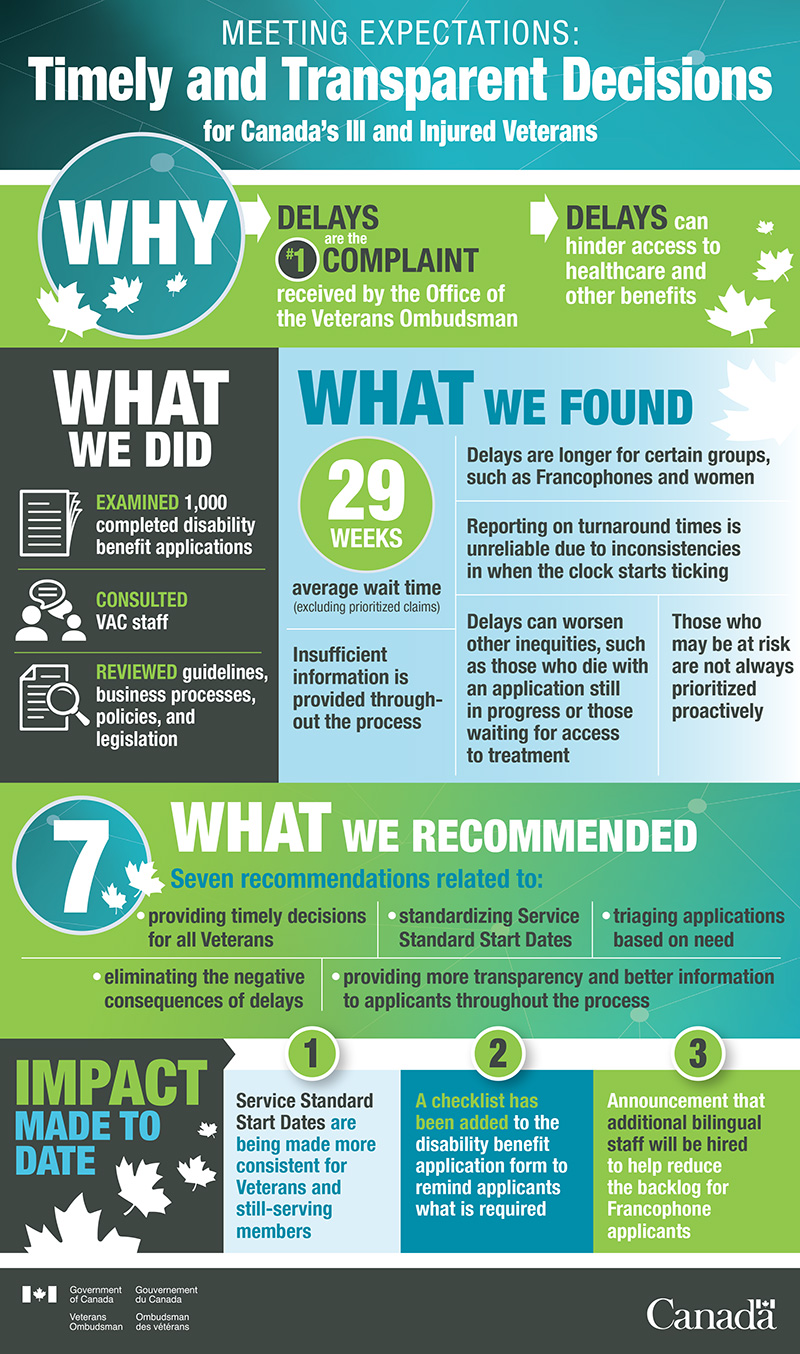
Alternative text
Why:
- Delays are the # 1 complaint received by the Office of the Veterans Ombudsman
- Delays can hinder access to healthcare and other benefits
What we did:
- Examined 1,000 completed disability benefit applications
- Consulted VAC staff
- Reviewed guidelines, business processes, policies, and legislation
What we found:
- 29 weeks average wait time (excluding prioritized claims)
- insufficient information is provided throughout the process
- delays are longer for certain groups, such as Francophones and women
- reporting on turnaround times is unreliable due to inconsistencies in when the clock starts ticking
- delays can worsen other inequities, such as those who die with an application still in progress or those waiting for access to treatment
- those who may be at risk are not always prioritized proactively
What we recommended:
7 recommendations related to:
- providing timely decisions for all Veterans
- standardizing Service Standard Start Dates
- triaging applications based on need
- eliminating the negative consequences of delays
- providing more transparency and better information to applicants throughout the process
Impact made to date:
- Service Standard Start Dates are being made more consistent for Veterans and still-serving members
- A checklist has been added to the disability benefit application form to remind applicants of what is required
- Announcement that additional bilingual staff will be hired to help reduce the backlog for Francophone applicants
Our Work: Sharing, Listening, & Staying Connected
Outreach and Engagement
Staying connected to the realities of Canada’s Veterans and their families is essential to the Office of the Veterans Ombudsman’s (OVO) work. Through stakeholder meetings, town halls, and digital engagements the OVO strives to connect with Veterans and their families and to share the results of our work.
Canada’s new Veterans Ombudsman Craig Dalton hit the ground running with a quick pace, meeting with Canadian Armed Forces and RCMP Veterans, their families, and Veterans advocates and organizations from across the country.
Outreach by the Numbers (2018-2019)
Social Media Analytics
Twitter: 2,900 Followers (17% increase)
Facebook: 5,680 Followers (11% increase)
Instagram: 91 Followers (New)
Other Stats
6 Major Stakeholder Meetings
1 Facebook Live Event- question and answer session with the Veterans Ombudsman. This event reached 41,920 people and 9,622 engagements were made.
2 Parliamentary Committee Appearances.
SMost Popular Social Media Posts
Pension for Life Infographic: 48,500 Reactions

Alternative text
Facebook post about Pension for Life: What’s Changing? from March 28, 2019 received 48,500 reactions. Infographic, with caption: “We developed a chart to help our staff explain the changes to Veterans and their families brought about by Pension for Life. By sharing it, we hope it will be helpful to you as well”.
VAC Accounting Error: 20,537 Reactions
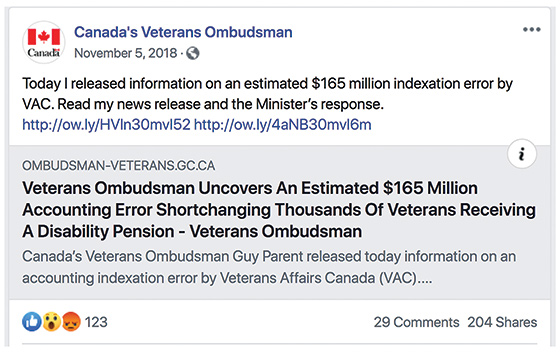
Alternative text
Facebook post about an OVO News Release entitled Veterans Ombudsman Uncovers An Estimated $165 Million Accounting Error Shortchanging Thousands of Veterans Receiving A Disability Pension, from November 5, 2018 received 20,537 reactions, with the caption: “Today I released information on an estimated $165 million indexation error by VAC. Read my news release and the Minister’s response https://www.ombudsman-veterans.gc.ca/eng/media/news-releases/post/54 ”
Wait Times Report: 14,872 Reactions
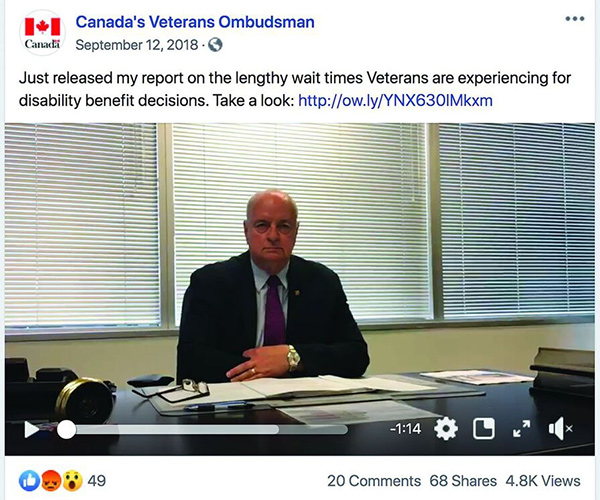
Alternative text
Facebook post video of former Veterans Ombudsman Guy Parent introducing Meeting Expectations: Timely and Transparent decisions for Canada’s ill and injured Veterans report from September 12, 2018 received 14, 872 reactions. The video was captioned: “ Just released my report of the lengthy wait times Veterans are experiencing for disability benefit decisions. Take a look: https://www.ombudsman-veterans.gc.ca/eng/reports/infographics/timely-transparent-decision”
Veterans Ombudsman Advisory Committee (VOAC)
VOAC provides advice to the Veterans Ombudsman on issues related to his mandate. The committee, through their expertise and knowledge, assists in promoting the well-being of all Veterans and their families by identifying emerging issues of importance to the Veterans' community and by providing advice to the Ombudsman on how to best approach those issues.
2018 Members
Dave Leblanc; Al Rivard; James Popplow; Heidi Sveistrup; Pierre Allard; Heather Armstrong; Luc O’Bomsawin; James Brown; Stacey De Savoye; and Jim Lowther

Veterans Ombudsman Commendation Awards
The Veterans Ombudsman Commendation is awarded annually to deserving recipients across Canada. The recipients are nominated by their peers and selected by committee for the lasting difference they make in the lives of Veterans and their families. These individuals and groups exemplify leadership, and show incredible dedication to their work.
2018 Recipients
Local Organization:
RCMP Veterans Association Support & Advocacy Team (NS Division)
National Organization:
Prince’s Operation Entrepreneur (POE)
Individuals:
Dr. Tim Black – Professor University of Victoria; Leah M. Cuffe – Military Spouse; and John Lenwood Roach – retired Royal Canadian Navy.
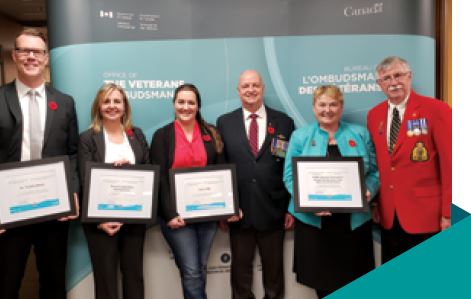
Financial Statement
As per the 2018-2019 Departmental Plan, the Veterans Ombudsman’s planned spending was $5.4 million for fiscal year 2018-2019. The actual authorities at the end of fiscal year 2018-2019 were $5.4 million.
| Organization | Salary (Planned) | Operating (Planned) | 2018-19 Planned | 2018-19 Authorities |
|---|---|---|---|---|
| Office of the Veterans Ombudsman | $2,872,300 | $973,900 | $3,846,200 | $3,967,306 |
| Veterans Affairs Canada (provision of services to the Office) | $802,453 | $179,408 | $981,861 | $981,861 |
| Employee Benefit Plan | - | - | $558,562 | $410,917 |
| Totals | - | - | $5,386,623 | $5,360,084 |
| Program or Operational Requirements | Expenditures |
|---|---|
| Salaries and Wages | $2,791,738 |
| Total Salaries and Wages | $2,791,738 |
| Transportation and Communications | $176,712 |
| Information | $39,402 |
| Professional and Special Services | $204,196 |
| Rentals | $14,739 |
| Purchased Repair and Maintenance | $11,933 |
| Utilities, Materials and Supplies | $35,933 |
| Acquisition of Machinery and Equipment | $9,005 |
| Other | $345 |
| Total Operating Expenditures | $492,265 |
| Total – OVO | $3,284,003 |
| Program or Operational Requirements | Expenditures |
|---|---|
| Salaries and Wages | $775,173 |
| Operating Expenditures | $159,555 |
| Total | $934,728 |
| - | Expenditures |
|---|---|
| Office of the Veterans Ombudsman | $3,284,003 |
| Veterans Affairs Canada (provision of services) | $934,728 |
| Employee Benefit Plan | $527,526 |
| Other (Paylist Allocation etc) | $40,509 |
| Total Expenditures | $4,786,766 |
